JOHN HOWLETT
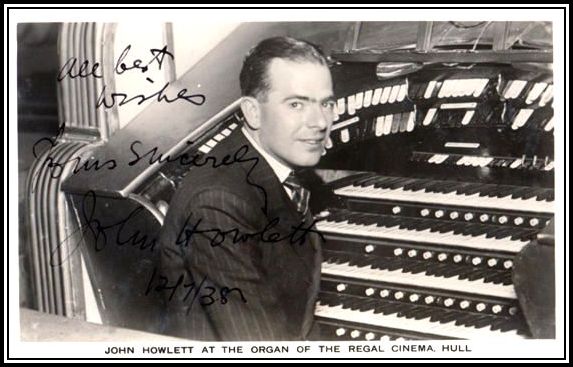 -oOo-
-oOo-
THE MUSICAL DIRECTOR
FOR WEST END THEATRES
The Theatre Organ of the Odeon Theatre Leicester Square has always enjoyed a good reputation amongst those that have played it. In addition, its builder, John Compton, always thought highly of it. John was very happy to be the Resident Organist here since he also considered this Organ to be an exceptional instrument. In addition, he found, as a Theatre Organ, that it also proved to be first-rate Concert Organ although he was never fond of the Melotone and employed it sparingly.
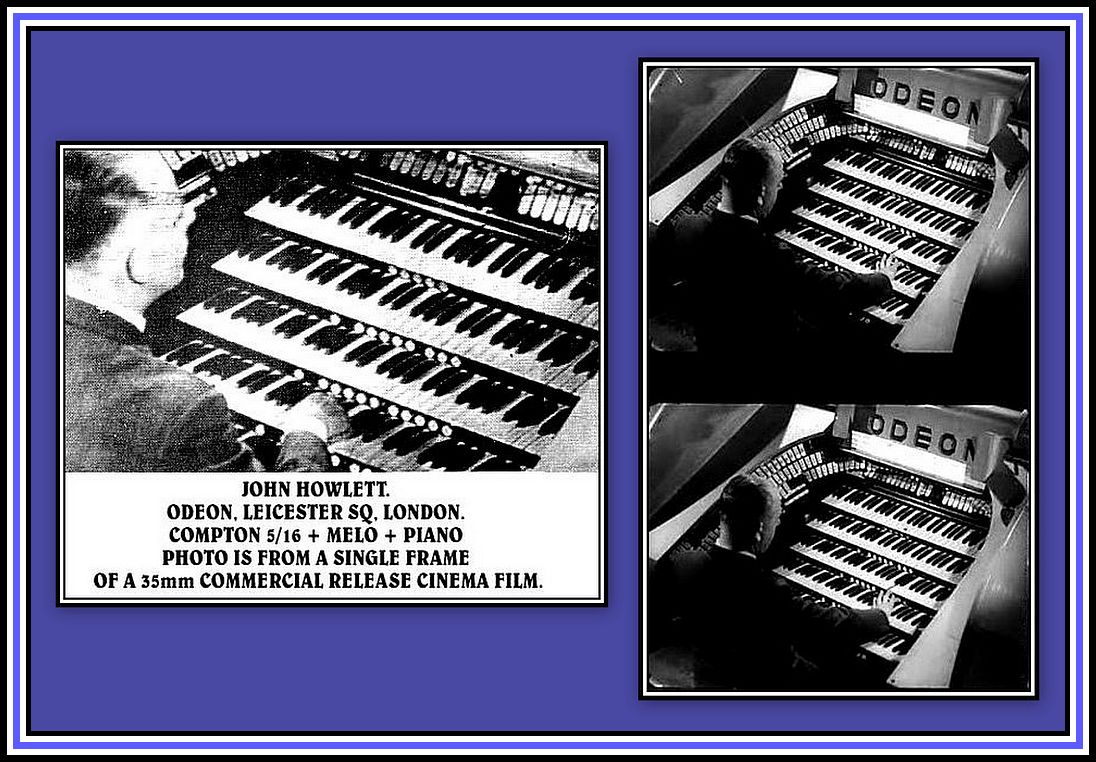
-oOo-
Being the Resident Organist at the Odeon Theatre Leicester Square did not mean just playing a Musical Interlude before the major feature. It also meant playing at the many Guest Nights, Film Premieres including World, European and National together with the Press Shows that took place at the Theatre. In addition, his position also required him to make suggestions as to which Organists should perform at the other Theatres of The Circuit. As a result, John said that he had never worked as hard as he did during the first six or seven years here.
-oOo-
For the record, John’s official title with Odeon Theatres Limited during his time as Resident Organist at the Odeon Theatre Leicester Square was Musical Director for West End Theatres.
-oOo-
Also for the record, John would often refer to the Odeon Theatre Leicester Square, as The Leicester Square Mission Hall. Perhaps as a result of this, Gerald Shaw, the Theatre Organist, gave John the nickname of The Bishop. Both John and Mr. Shaw were said to have wicked senses-of-humour!
-oOo-
MEMORIES
According to family members, John had many memories of his time as the Resident Organist of The Odeon Theatre Leicester Square and what follows in this section is a few of his special memories.
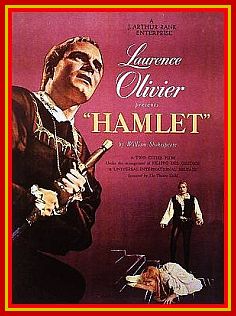
When the Laurence Olivier (1907-1989) film of Hamlet was premiered in 1948 at the Odeon Theatre Leicester Square, John played J. S. Bach’s Toccata and Fugue in D Minor, as the introductory music. Seemingly, his rendition was greatly appreciated by the audience, which encouraged Mr. John Compton, the Organ’s builder. to write to him to express his praise and admiration.
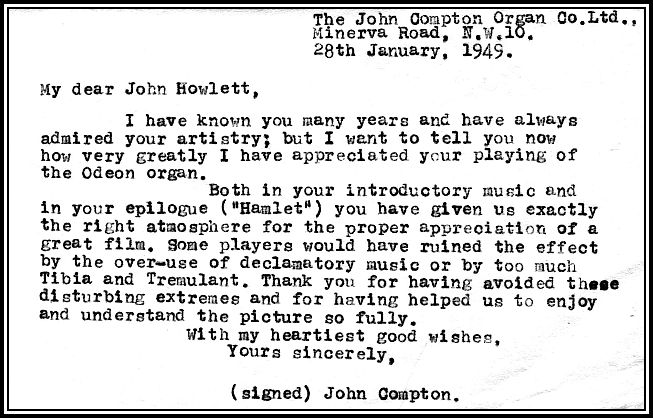 The Letter from John Compton
The Letter from John Compton
-oOo-
J. S. Bach’s Toccata and Fugue in D Minor played by E. Power Biggs (1906-1977)
-oOo-
Recently, I sat down in a very comfortable chair and settled back to listen to a version of J. S. Bach’s Toccata and Fugue in D Minor. Sadly the version that I listened to was not that of Mr. Howlett, but one can not have everything, can one? Once the music came to an end, I then re-watched Laurence Olivier’s Hamlet. I had paused my DVD-player so that I could start the film immediately the music ended thereby allowing me the pretense that huge curtains were being swept open to reveal the opening of the film – always an exciting moment!
Although neither my sitting room, no matter how comfortable my chair, nor the size of my television screen could possibly allow me an comparable experience to that enjoyed by the audience, including Mr. John Compton, on that night at the Odeon Theatre Leicester Square almost seventy years ago. However, in my makeshift auditorium, the majesty of the introductory music that still set the hair on the back of the neck upright and created an atmosphere that allowed me to appreciate the grandeur of the film. Perhaps what I experienced was nothing more than a mere taste of what the audience actually felt at the premier, but nevertheless I found my experience to be An Event!
-oOo-
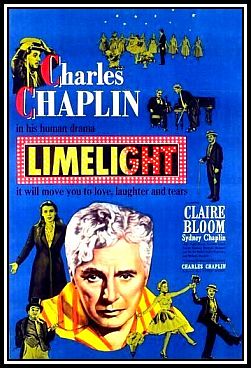
Another memorable film premier held at the Odeon Theatre Leicester Square was Charles/Charlie Chaplin’s Limelight held in 1952. John introduced the theme song in his pre-screening Musical Interlude. Unfortunately there was no copy of the score available at the time of screening and John had to learn it directly from Charles Chaplin (1889-1977) who sang it to him at his suite at The Savoy Hotel prior to the premier.
Theme from Limelight played by Frank Chacksfield (1914-1995) & His Orchestra
-oOo-
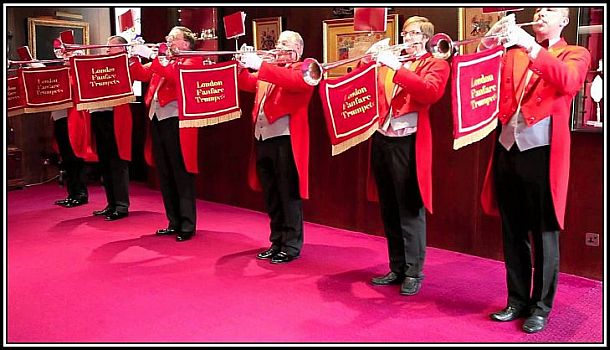 Fanfare Trumpeters
Fanfare Trumpeters
A particular favourite memory of John’s from his time as the Resident Organist was when he played the National Anthem with the Metropolitan Police Band and Fanfare Trumpeters. John said that he found this to be a very moving experience and apparently the addition of the Trumpeters was the idea of the Theatre’s General Manager of the time, Mr. Bill Thornton and has since been copied many times.
-oOo-
The Metropolitan Police Band playing London Calling by Eric Coates (1886-1957)
Fanfare Trumpeters
-oOo-
The Royal Command Film Performance is a yearly event that is sponsored by The Cinema and Television Benevolent Fund and where a major film is chosen and showcased before The Queen or her representative with all proceeds being given to a specific charity. It is an honour for a particular film company to have its film chosen for presentation and has generally added to its box office success. The Event always proves to be a glittering affair.
-oOo-
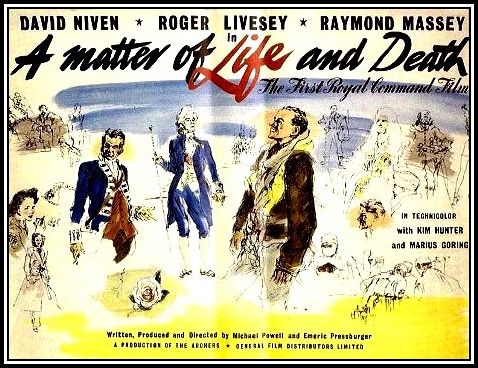
Click here to watch a short video (soundless) of the first Royal Command Film Performance (1946)
King George VI attended the first Royal Command Film Performance in 1947 with the showing of A Matter of Life and Death and directed by Michael Powell (1905-1990) & Emeric Pressburger (1902-1988). This Gala Event took place at the Odeon Theatre Marble Arch where there was no stairs up to the circle where the Royal Party was to sit. This venue was chosen since The King suffered with knee problems and needed to avoid any climbing.
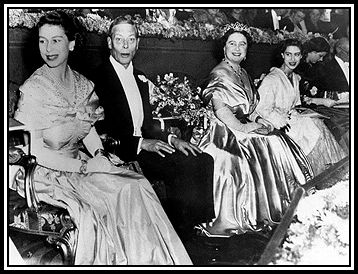 King George VI (1895-1952) & Queen Elizabeth (1900-2002) with
King George VI (1895-1952) & Queen Elizabeth (1900-2002) with
the Princesses Elizabeth (1926) and Margaret (1930-2002)
at the first Royal Command Film Performance (1947)
Subsequent Events have been attended by The Queen, The Queen Mother, Prince Charles and the current Duke and Duchess of Cambridge amongst others.
These Galas are always spectacular Events where a number of people, especially those in the entertainment business including film stars and others in the film industry, meet a member(s) of the Royal Family. Until 1961, the Event alternated between the Empire Theatre and Odeon Theatre in Leicester Square when the Empire Theatre underwent changes to the building so that it no longer housed a sufficiently large auditorium suitable for such a Gala Event.
-oOo-
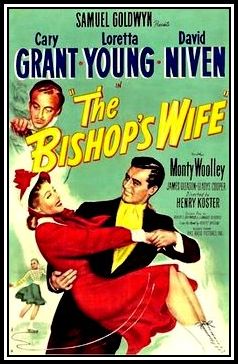
The first Royal Film Performance held at the Odeon Theatre Leicester Square was on the 25th November, 1947 with the screening of The Bishop’s Wife. The Event took place soon after John took up residence at the Theatre and was the first of six such Events that he took part in, and on at least one occasion, he was presented to the Royal Party. He also danced with Princess Margaret while attending a Tin Pan Alley Ball at the Dorchester Hotel in London.
-oOo-
Another important event that John was proud to be a part of was the holding of the International Congress of Organists in 1957. During the Congress, John had the opportunity to show a number of the delegates the Theatre Organ of the Odeon Theatre Leicester Square and to play for them.
-oOo-
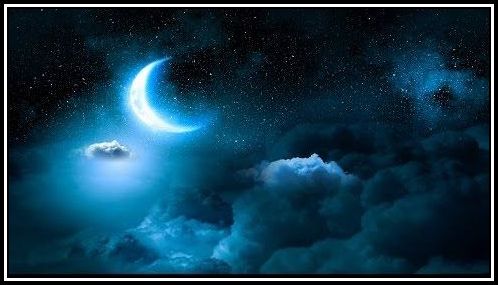
During his tenure as Resident Organist of The Odeon Theatre Leicester Square, John also made a number of live broadcasts for the BBC Light Programme series, Moonlight Lullaby. These programmes were made between 11.20 p.m. and midnight and included an eclectic mix of music, which was always well received by the listening public.
-oOo-
What follows are recordings of two pieces that John made while Resident Organist at The Odeon Leicester Square for the BBC Programme, At The Console, and which aired in November 1956.
John recorded several of his broadcasts that he made for the BBC. Later, these recordings were transferred to cassette tapes and eventually put into storage until recently when several of these tapes, including these pieces, were kindly uploaded to digital format by Mr. John Leeming. These recordings appear here with permission of his family.
The first piece to be heard is John playing what was essentially his signature tune, My Song goes ’round the world:
My Song Goes ’round The World
This is followed by the announcer introducing the programme and giving details of the first piece to be played from the Ballet égyptien by Alexandre Luigini (1850-1906):
Introduction to the Programme
Movements 1 & 2 from the Ballet égyptien
The announcer next introduces The Overture of The Light Cavalry by Franz von Suppé (1815-1895):
Introduction to the next piece, The Light Cavalry Overture
The Overture of The Light Cavalry
—ooOoo—
ACKNOWLEDGEMENTS
I would like to thank Mr. John Leeming for his invaluable help in the preparation of this piece and for uploading the musical pieces to digital format.
Special thanks are offered to the family of Mr. Howlett, and in particular to Ms Amanda Ratcliffe and Ms Emma Coleman, for providing photographs and information on his life.
I would like to thank Mr. Paul Bland for providing a number of photographs and links.
Many thanks for allowing the reproduction of photographs, drawings and information are also due to: Mr. Gavin Jones of the Black Country Bugle; Mr. Adam Phillips of the Express & Star, Wolverhampton; Ms Emily Randall, Senior Membership Development Officer at the Historical Association, Bournemouth; Mr. Michael Stead, Heritage Team at Bournemouth Library, Bournemouth; Mr. Matthew Lloyd for allowing the drawing of the Putney Palace that is reproduced from his website; and Mr. Nick Smith.
Special thanks are offered to Mr. Anton Stromlund for providing a copy of his playing of a Danish children’s song.
—ooOoo—
—ooOoo—
